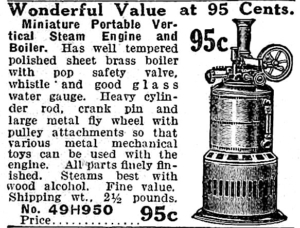Use cases. It’s simply a term for capturing the functional requirements of a digital library. Each use case is written from the user’s perspective, defining who they are and how they want and expect to use the digital collection.
Understanding use cases is essential for determining how a collection will be best delivered, and what functionality needs to be built in.
Let’s imagine a collector owns a Sears, Roebuck, and Co. personal library of catalogues* that spans nearly 75 years, and they want to digitize it. Right now, they’re the only person using it in their study of American history to provide the cultural context of what people were buying, using, and interested in at particular points in time.
Currently, the magazines in the collection are physically arranged by date—this is how the collector imagines they will organize the collection digitally. They have already done a lot of physical work to categorize the collection, including making notes of what is in which volume.
The collector wants to make their collection of catalogues available to other historians, schools, and individuals, so they decide to employ a technical archival company to help develop the digitized collection and figure out the best way to showcase it.
When the collector talks to an archival company, one of the questions a digital archivist asks is, “What are your use cases?”
In other words, who will use this collection? In this imagined case of a digitized Sears catalogue collection, the collector works with the archival company to make estimations of these categories of users:
- Historians and collectors
- Students
- Librarians and researchers
- Historical Fiction Writers
Next, a sample of potential users should be interviewed about how they would like to use this collection. It’s important to talk to users directly because the quality of requirements will be better if they come directly from the users. Assuming how a group would utilize the collection could mean missing something crucial.
Read more about how Anderson Archival builds digital collections!
Discovering the use cases for these specific groups will help determine how the collection will operate, how it will appear, and how it will be accessed.
The first interview is with a researcher of Western Expansion. She wants to do specific research on the homes available for purchase in the catalogue. She plans to compare the results found in this collection to others she has found in scholarly work. She mentions that she would like to use search to narrow results by date, model number or name of the house, and price range. She wants to be able to search for exact phrases found in scholarly work, to verify that it appears in the collection.
The second interview is with a university student. He informs the interviewer that he does much of his electronic research on his phone. He mentions that he usually sends interesting articles or pictures to himself to later reference.
And the interview process continues.
The collection will need to accommodate the needs of all of these interviewees. Some key points of the interview findings might look something like this:
| Historians and collectors | Need a way to save pertinent documents or quotes easily. Want the ability to print historically accurate pages. |
| Students | Want a fast, accurate search of keywords, mobile access, and the ability to share pages electronically. |
| Librarians and researchers | Know what they are looking for and expect to be able to search dates, volumes, and issues. Want to search exact phrases and verify what they know is in the collection. |
| Historical fiction writers | Want to page through issues to get a sense of the era and need to search by date, category, or item type. |
Once interviews have concluded and use case scenarios have been compiled, a technical archival company can then recommend the best tools, and in some cases, a custom software solution for the collection.
For Anderson Archival, this step is utilized in the development process. Knowing the current and potential users of a collection helps to determine how best the digital library should be delivered. Options can be as simple as using a PDF viewer to access a private library for only a few users, to as complex as custom online software with logins.
Technology is constantly evolving. If the collector wants to invest in digitizing right the first time, the collection should be optimized for cutting-edge technology so it will easily adapt to the new and better software and hardware developed every year.
Of course, each collection will be different and have specific needs for digitization, tagging, and its interface, but the goal for anyone digitizing their collection and defining use cases is to make their collection accessible and functional for as many types of users as possible.
Here are a few more tips for building your use cases:
- Consider how your collection is different from others. What features could this collection offer that others do not?
- As you think about use cases, focus on users’ functional needs and not software design.
- Often, collectors think they know how users will use the collection, but actually interviewing potential users will uncover needs for critical functionality that otherwise is likely to be lost.
- Developing detailed use cases, taking the time to learn from users, will make the final product of your digital collection much better!
Whether you’re developing use cases for a private collection or because you want to share your collection with the world, once your collection is digitized, you’ll have peace of mind. Your digital library will be preserved for generations to come and now others will be able to interact with it easily and share it.
If you want help developing a use case for your collection, contact Anderson Archival at 314.259.1900 or email us today!
*This theoretical collection is used purely for example purposes. Sears has a portion of their catalogue available online here.



